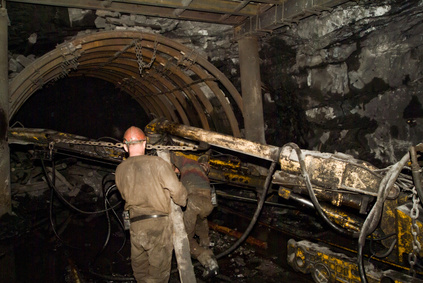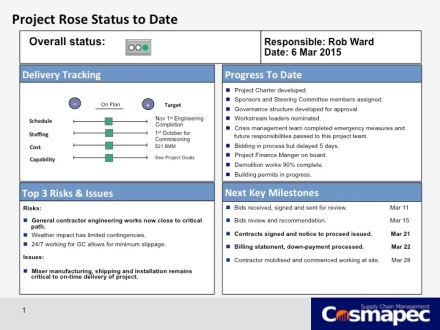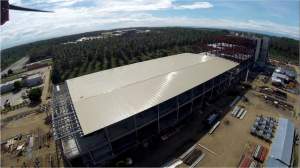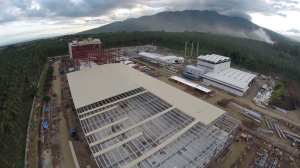Project management remains a popular subject, and this series of articles, here, here and here were amongst the most read early in the life of this blog. The originals were written with a strong emphasis on our experience of establishing supply chains in developing markets, so to extend their appeal they have been combined and updated with content relevant to a wider range of situations. This post also provides a background for our next articles.

Why Projects Fail
This article looks through the lens of our experience ‘at the coalface’ to give you insight into how to develop a project that works. Unlike strategy, which is highly reliant on innovation and uniqueness to create a successful ‘roadmap’ for the future, project management has a well-established format for completing on-time, on-budget and to the right quality. Despite this well-known framework, project failure is far from uncommon. So why do so many projects fail?
There are many factors, but context our experience tells us that these 6 are the major stumbling blocks:
- Scope uncertainty. At the start of the project it is essential to clearly outline the scope. This is not a design, although that will become a part of the scope, but rather clear descriptions of the expected outcomes. In supply chains this is usually expressed in terms of capabilities: Typically these could include capacity, cost per unit produced, inventory turns, return on capital etc. Most projects are about creating something, and defining clearly what the expected outcome looks like is essential. Without a clear scope, monsters will infest your project.
- Lack of resources. New projects and initiatives require considerable amounts of time above and beyond business as usual. Budget or headcount restrictions often dictate that organisations look to existing resources. The predictable outcome is that something isn’t done well, or done on time. That something is usually the project work.
- Divided accountability and responsibility. This often goes hand in hand with the previous point. If the project team members end up with more than one manager as a result of finding themselves on the project, then it can divide their accountability and responsibility to the project.
- Hostility. Multiple and diverse reasons exist for hostility towards a project. Envy, fear, uncertainty and doubt to name a few. Uncontrolled these can kill projects. Dealing with this is a key role of the project sponsors and leaders.
- Disconnects with reality. Projects exist in the real world where constraints and restrictions are the rule, and not the exception. Refusing to recognize them doesn’t make them go away.
- Absence of sponsorship. Projects need sponsors. With sponsorship, the failure points above can be acted upon. Without it they will not be. Internal or external consultants can be critical in identifying the key pressure points for project sponsors to enable timely intervention.
These six points have a common origin in project governance, and particularly leadership and sponsorship. Being aware of these risks and planning to avoid them is critical to project success. In the next part of this post we will cover how to define project scope.
What You Need to Know About Scope.
Without a clear scope, you will be constantly challenged by changes to the end-state vision, or the project manager’s deadliest enemy, scope-creep. In the preparatory stages of a project you will find two documents essential to define the scope: These are the project proposal and approval document, and the project kick-off document. Although these are deceptively simple in their format, the information and decisions that they record define the project’s objectives and key descriptions of what success will look like.
The proposal and approval document presents in one to two pages the key information necessary to move a project from a proposal to an approved part of the project portfolio or programme. The project objectives are summarised in a paragraph or a few bullet points. The benefits and expected costs are outlined, and the key resources and timings. Dependencies to other projects are determined, and known risks briefly described. A summary of the strategic fit aligns the project with overall business objectives. Finally the form provides a section to record the approval to proceed from the business leaders responsible for authorising the expenditure and allocation of resources.
The project kick-off document contains more details about how you organise the project to achieve the project goals. It is often necessary to put together much of the content of the kick-off document to be able to prepare the proposal for approval. It is used as the agenda and materials for the kick-off meeting with the team selected to implement the project. Here are the main sections of a kick-off document:
- Background, why the project is being initiated.
- Strategic fit with overall business objectives
- Goals and deliverables.
- Scope, what is included, and what is not.
- Top-level work breakdown structure and main workstreams.
- Project organisation structure.
- Review process (review meetings schedule and reports required).
- Financials.
- Level 1/2 Gantt chart with key decision point milestones.
- Risks and dependencies.
- Key next steps.
Each kick-off document is unique, but for an organisation that is constantly evolving, it is useful to develop standardised formats to ensure nothing is missed at the kick-off stage. Most of this information applies to all projects. Perhaps the most critical input at this point of a project is to create a work breakdown structure that accurately reflects the time and effort that will be required to complete it. For large projects, with multiple functional areas and processes it will likely be necessary to organise into workstreams, each with their own organisation and resources to execute the necessary tasks.
Once the project has been kicked-off it is crucial that the project sponsors take full responsibility for adherence to the agreed scope, and are the only part of the project organisation that can agree to any changes to the goals and deliverables.
Sponsors and Governance
So by now your project scope is clear, the work is planned, and the resources are in place. You have made a good start to the journey, but how will you navigate the long road ahead? In many ways the answer is to plan for failure, or more specifically how to avoid it, and governance is the key activity. What is governance, who does it, and who benefits from it? Simply put, governance is how the project owner gets the information needed in order to keep the project moving towards a successful outcome. Large projects typically impact across many operational areas, and as such a separate organisation structure is required to ensure work is completed as planned, and information flows to the key decision makers and project owner, commonly referred to now as the sponsor. Often overlooked is how to deal with the many issues that can lead to project failure. Which is where the project sponsor earns his or her money.
Lack of resources can seriously impact a project even when there is a clear project organisation chart with defined responsibilities. Projects compete with resources for ‘business as usual’ operations, and with other projects. The business environment never stands still and changing operational priorities often pull the project team members away from completing crucial tasks. When the project organisation is new, communications within it are often less effective than those in the regular business operations. Schedule slippages due to lack of resources can quickly build up between the formal project reviews. A key project management role at this stage is to continuously monitor that all the project resources are fully mobilised and that their scheduled tasks are being completed as planned. If resources are constrained, the sponsor’s role is to step in and make the judgment call between operational requirements and project objectives, and agree this with the organisation’s leadership team.
Accountability and responsibility can be divided as a result of projects, especially when project team members retain operational responsibilities alongside project roles. Emotionally, the project team members are likely to prioritise operational requirements above project requirements, especially if the project could impact on their future within the organisation. The project manager needs to be able to rely on the resources they have to be fully accountable, and responsible for their tasks. If this is not the case, then the sponsor needs to ensure corrective actions are made to re-focus the team members or replace them.
Hostility to a project is common but often underestimated. Some stakeholders and even project team members can be openly or passively obstructing the project. Identifying and dealing with this is crucial, and is a key responsibility of the project sponsor. The project manager rarely has the authority to deal with these issues, especially if they cross formal operational hierarchies. The project sponsor must have the executive authority to be able to raise hostility issues with the organisational leadership and take the necessary actions. These can be ‘make or break’ moments: Projects that no longer have the full support of the board should probably be halted, or be ‘ring-fenced’ to fully separate them from the rest of the operations. If opposition is external to the project organisation then this needs to be identified as a key risk and managed through communication, incentives, reward structures or disciplinary actions. If hostility is likely to be widespread from the outset, a formal change management programme may be required to manage this risk.
Disconnects with reality are frequent: We have noticed this especially when a project is in a new market or business area that the leadership is unfamiliar with. Expectations that the new markets can be managed in the same manner as existing ones can be misguided, and usually result in the symptoms of a failing project. Timescales may be unrealistic, cost estimates wrong, and the new market may have barriers to entry that exclude existing business models. This leads to dysfunctional outcomes, lateness and budget overruns. Sponsors need to make clear the realities of the business environment and manage expectations appropriately.
Absence of sponsorship is usually fatal to a project, and arguably should be. If there is no senior leader that is willing to back a project, it should be humanely killed before it succumbs to predators. If your project has not got a clear business benefit that the executive team is counting on you to deliver, and an equally clear commitment from them to getting it completed, then why are you doing it? Quality of sponsorship is the key indicator for project success. Sponsors need to be committed to the business case for the project, and have the authority and influence to resolve these well-known reasons for ‘Why Projects Fail’.
If you want to learn more about the Cosmapec approach to supply chain development, visit us at http://www.cosmapecsupplychainmanagement.com or contact us
About : Rob Ward has extensive global experience working in supply chain organisations. He co-founded Cosmapec to help companies and executive teams establish, develop and optimise their supply chains.










